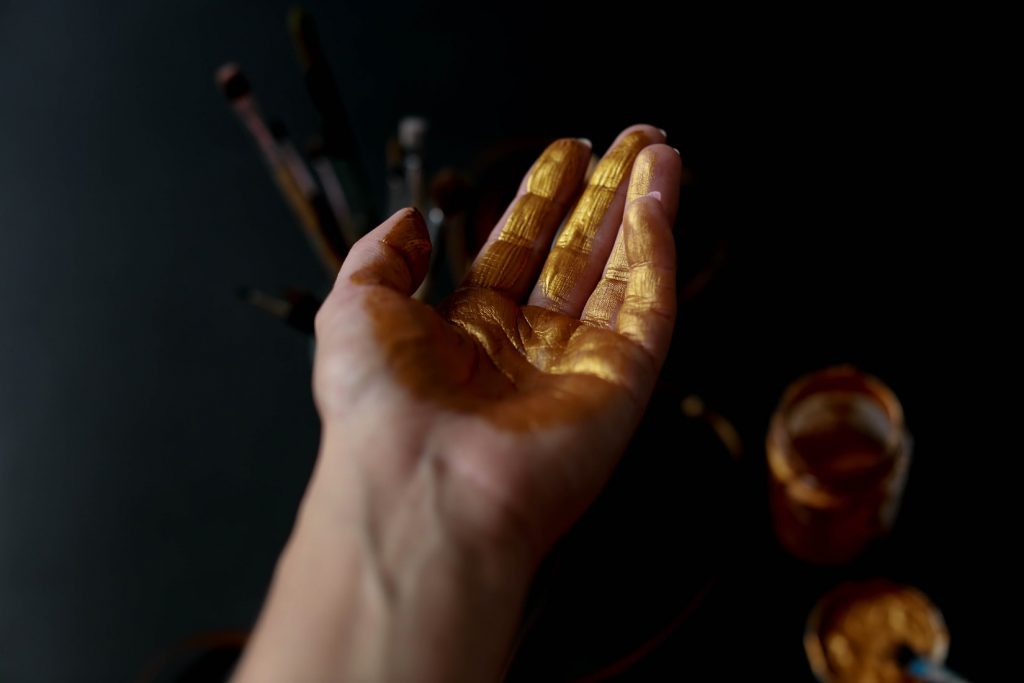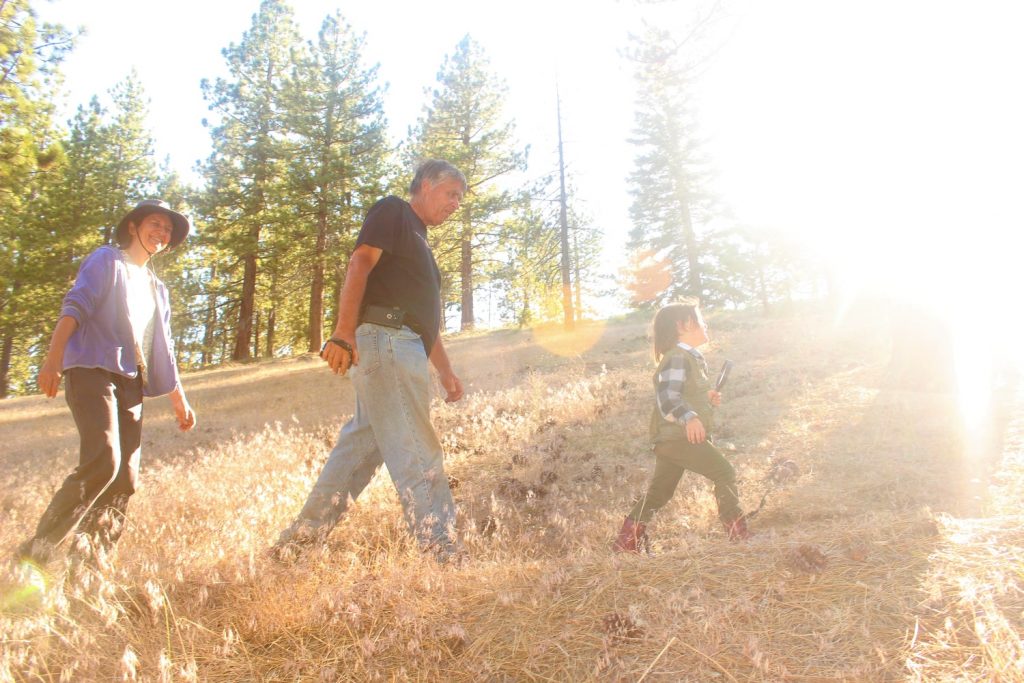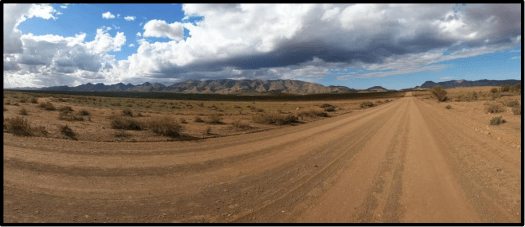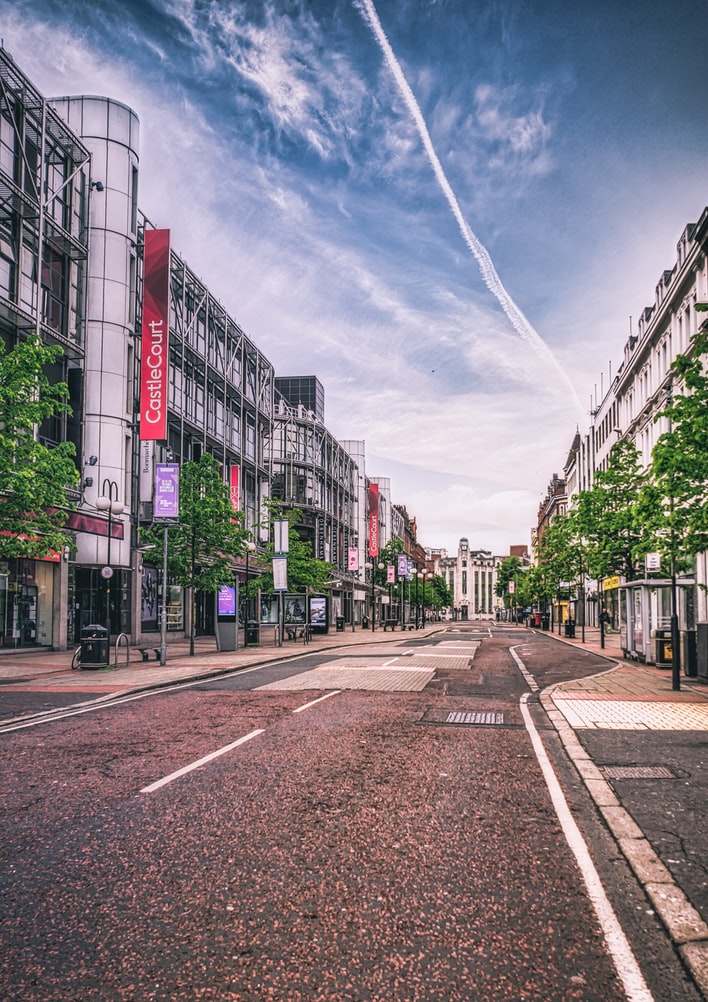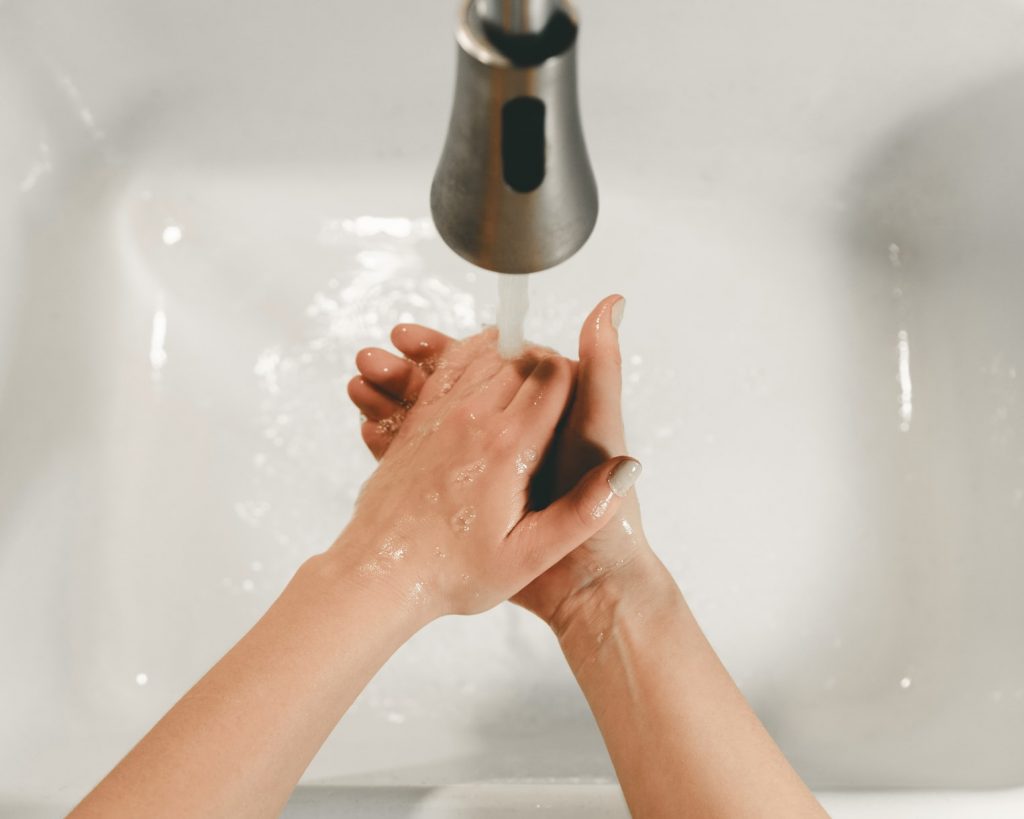
There are bodies on the sidewalk. Quinn’s eyes dart to them briefly. The closest of them, a man dressed in a tailored black suit, lies half-curled in the foetal position near the bus-stop. Another woman has collapsed two metres away from him, a half-eaten muffin fallen from her outstretched hand. A speckled finch cocks its head and hops closer, heedless of the wide berth given to the bodies by the rest of the early-morning crowd.
They’re not the only ones. There are other bodies: each one an unmoving stone in the flow of commuters. Quinn counts one, two, a trio over there, another in front of the alley, before she catches herself and tears her gaze away. The light ahead turns green and the bus rolls forward, nudging Quinn further into her seat. The bodies soon disappear, though her awareness of them lingers.
The bus trip takes twenty minutes. Quinn spends eleven of those fiddling with the cord of her earphones and the rest nervously cataloguing the other passengers. There’s a man in a black suit to her left across the aisle and two women spaced carefully at the front. They’re wearing masks, like Quinn, but above the blue fabric their eyes are half-lidded and weary. Quinn smooths unsteady fingers down the sides of her nose bridge, pushing the mask wire flush against her skin. They don’t look sick… but that doesn’t mean they’re not. The thought that one of them could be a carrier spikes anxiety into her stomach.
Through the window, Quinn spots the corner café she works at: Morning Brew. She stands as the bus draws closer, presses the buzzer, and waits as the bus driver pulls to the side of the road. When she pulls her hand away from the pole, the icy imprint of the metal stays like a brand on her palm. Quinn holds it stiffly at her side as she walks to her work.
Another dead body is slumped two feet from the entrance. It’s a girl, maybe the same age as Quinn herself. She’s wearing bright yellow heels, but the shoes are scuffed and almost falling off her feet, meaning she was dragged here—off the main footpath, perhaps, or out of the road. Quinn stares at the body for a long time, her keys clenched in her fist. Briefly, and selfishly, she wishes the girl had the forethought to die somewhere else. But she hadn’t, and neither had the person who’d moved her, and now it is Quinn’s problem.
She can’t move the body—can’t touch it—but the council truck won’t be by for hours and won’t it scare away customers? In the end, she leaves it there, not knowing what else she can do.
Quinn’s been working the opening shift for months. Now, the familiar mantra runs through her head like a printer churning kitchen dockets. Unlock the door, turn on the lights, drop your bag behind the counter and grab an apron. Keeping track of the places she touches is just another running list: key, door, light switch, cupboard handle. Her co-workers on the closing shift should have disinfected everything already but Quinn can’t trust that alone. She’ll go over everything again before the café opens. But first – as she thinks about the dead girl on the café’s doorstep – her hands.
There’s sanitiser tucked beneath the counter. Her hands are still raw from this morning, when she scrubbed her hands free of bacteria after getting on the bus. Quinn smooths the cold gel over her palms, along the backs, in the gaps between fingers and on the half-moons of her fingertips. The cracks in her dry, roughened skin reveal themselves with stinging complaint but the ache, too, is routine. She dries her hands with a flick of her wrists and moves on to the rest of the café.
For a half-hour, she’s alone. Then the bell above the door rattles when she’s in the middle of fitting the filters into the coffee machine and Quinn glances up. It’s the new hire, she realises. He’d replaced Alyssa, she remembers, after the poor girl was found keeled over in the backroom. The café had been closed for a week for de-contamination. The new guy’s name was… Kenny? Kyle? Then the young man gets close enough for Quinn to glance at his name tag. ‘Hey, Kevin,’ she manages, hiding her relief.
‘Hi! You’re Quinn, right? I can’t believe this is our first shift together!’ exclaims the other guy. He’s grinning at her as he sticks out his hand. For a heartbeat, Quinn moves to shake it – and then the realisation clicks in and she steps back instead.
‘Woah,’ she says. ‘Did you sanitise yet?’
‘Oh.’ Kevin pulls his hand away from Quinn and covers his mouth as he laughs. He’s touching his face, Quinn thinks, dismayed. ‘Whoopsie-daisy! Sorry, I’m just, like, still getting used to it all. Did you see that girl outside? I totally almost went to ask if she was okay before I realised, she was, like, dead. You know?’ He laughs, but it comes out nervous and brittle.
Quinn can sympathise, even as her heart trembles at Kevin’s near miss. That instinctual empathy – the desire to help – had almost been their downfall when the sickness had first emerged, before they’d learned to avert their eyes and keep their distance instead. A government ad campaign had been reinforcing that lesson for weeks now: SAVE OUR BUSINESSES, NOT THE BODIES! The economy, after all, was what would save them.
No one said how exactly, but Quinn has been told it enough times to know it’s true. It’s why she’s here, in the café, setting up while there’s a dead girl outside the doors and more bodies in the street than she can count. And, speaking of the economy… Quinn sighs and beckons for Kevin to follow her behind the counter where they keep the sanitiser and PPE. ‘Come on,’ she says, and reaches for a pair of gloves. ‘We have to move it.’
‘Move what?’ asks Kevin, and then he pulls a face. ‘The girl? Ew, Quinn. Can’t we just wait for the council truck?’
‘That could take hours,’ she counters. ‘The café opens in twenty minutes.’ And we’ll both get fired if we don’t, she thinks.
Kevin huffs – but Quinn is right, and they both know it. After a moment’s hesitation, he sanitises his hands and reaches for a face shield. Once they’re both covered head to toe in multiple layers of protective equipment, Quinn leads the way to the door. Outside, a few people do double-takes and then veer in a wide circle to keep clear of them both. Quinn senses Kevin’s grimace even through the mask.
The dead girl has listed slightly to the side since Quinn saw her, her blue eyes open but sightless. Quinn swallows against the sudden lump in her throat and averts her gaze. ‘You take her ankles,’ she suggests. ‘I’ll grab her wrists.’
‘And take her where?’ whines Kevin, and Quinn feels a flash of irritation. Does he think she wants to move the body? ‘The dumpster?’
Quinn shakes her head. ‘There’s a collection point down the street. We’ll take her there.’
Despite her brave face, Quinn fights a physical wave of revulsion as they manoeuvre the body flat onto the ground and then she wraps her fingers around the girl’s slim wrists. Even through her plastic gloves, Quinn can feel her ice-cold skin and imagines the sickness slowly transferring through their touch. The thought is almost enough to make her panic.
She fights the feeling as they struggle down the street, the body swinging stiffly between them. The streets are emptier now, but the few pedestrians hold their hands over their masks and hurry onwards when they see Quinn and Kevin with the body between them. No one wants to be near the infected.
The collection point is marked by the spray-painted warning signs on the surrounding ground and the four-post pavilion. The cover is supposed to protect the bodies from the elements, which Quinn supposes she appreciates. The bodies start to stink if they’re left out for more than a few days already; she can’t imagine the stench if they were left out to be roasted by the sun or bloated by the rain. Today, fortunately, the collection point is almost empty. There’s only an old man settled at the centre and a young girl, a child, placed carefully right on the edge. Quinn’s grateful for it; she doesn’t know how her nerves would have held up if she’d had to add to a pile. Even the thought of it makes her skin crawl.
With a grunt, Kevin throws the girl’s ankles down. Her battered yellow heels thud lifelessly against the pavement. Quinn winces and lowers the upper half of her body with slightly more care. Then she steps back and realises they’re too close to the edge. She checks her watch, though the face of it is dim and hard to read through her plastic scrubs. It’s almost time to open. Quinn bites her lip, deliberating quickly. She doesn’t want to be left alone with the bodies, but if the café doesn’t open on time… Well, then she’ll really be dead.
‘Go back to the café,’ she instructs Kevin eventually, who visibly sags with relief. ‘I’ll follow. And don’t touch anything!’
Kevin acknowledges her with a brief salute and then turns back. She watches him for a moment, wishing he’d offered to stay. Then, resigned to her task, she turns back to the body and grabs her ankles this time. Her blue eyes are still, awfully, open. Quinn tucks her chin into her shoulder and drags her closer to the centre, away from where an unsuspecting pedestrian could stumble into her radius of infection.
Invariably, though, after she settles her, Quinn’s gaze drifts back to the dead girl’s face. Dragged like this, the girl’s blonde hair—once neatly curled—has become filthy and matted. Her mascara’s smudged, too, in black streaks beneath her eyes. And Quinn knows it’s stupid but until the sickness, she’d thought all dead bodies were supposed to look peaceful.
Quinn knows better now. Underneath the dirt, and the black smears, and the emptiness behind her eyes… she looks scared, just like the rest of them. Hell, Quinn knows that fear intimately. She had been terrified when the reports had first flooded in: people dropping dead on the streets, stiff bodies left to rot on sidewalks. She’d thought the world as they knew it was ending. Two weeks later, though, it’s still business as usual, minus the corpses on her daily commute.
But she’s adjusting to those, too. Like everyone else is.
She turns and goes back to the café. True to her instructions, Kevin’s finished opening—though fortunately, with Quinn still in her PPE, there’s no customers inside to be scared off yet. She slips inside and goes straight to the backroom to strip it off: her gloves, mask, face, shield and scrubs. Kevin’s is already neatly bundled into a sealed plastic bag, ready to be burned. When Quinn finishes up and re-enters the serving area, she sees Kevin mopping her contaminated footsteps off the floor. His wrists are still pink: he must have scrubbed his hands raw after he’d returned to the café, terrified that the sickness would transfer.
Quinn sanitises her hands again and ties on a new mask. She’s disinfecting the countertops—again—when the doorbell jingles. The cheerful noise is jarring after the stress of the morning, and Quinn nearly jumps. She takes a deep breath to collect herself, ignoring the sweat beading on her forehead, and then glances up from the counter. Kevin’s already pulled away to greet the trio of customers, his brown man-bun wobbling precariously atop his head. It’s selfish, Quinn knows, but she stays behind the counter instead of joining him. Her earlier exertion has left her tired and flushed, so she’s not in the mood to put on a customer-service smile.
Once the customers are seated and their orders taken, Kevin saunters over so that Quinn can punch it into the register and get started on their drinks: a mocha and two lattes for the three women. She pivots to grab three cups from the cupboards, but a wave of dizziness knocks her off-balance. She halts, reeling from the sudden light-headedness.
Kevin, watching from the other side of the counter, notices immediately. ‘Are you alright?’ he asks.
Quinn hates that she knows exactly what he’s thinking, hates that she’s thinking it too. ‘Don’t be stupid,’ she snaps, harsher than she meant to. ‘I’m fine. Just tired from moving the-’ She hesitates, glancing at the three customers. They’re not paying attention, but she lowers her voice nonetheless. ‘The body.’
‘Yeah, it was pretty heavy.’ Satisfied, Kevin turns his attention to the machine again. ‘You’ll make ‘em, right?’
Quinn flicks an irritated glance in his direction. Kevin would have been taught how to make all the different drinks on his first shift, so it’s not like he needs her help. But Quinn’s the senior employee: she should set the example. ‘Fine, but you can plate their pastries.’
Once he’s gone, Quinn refocuses on her task. By now, the process of each drink is routine and almost mindless. She’s pouring the steamed milk into the second latte when another wave of dizziness hits her, stronger than the first, and the metal jug slips from her hand. It falls to the floor with a loud crash and hot milk arcs over the tiles.
Quinn barely sees it. Darkness swims at the edge of her vision and her balance is gone—she stumbles, catching herself against the edge of a counter. She hears Kevin call her name, panicked, but it’s distant, muffled—like he’s in another room. A third wave of dizziness slams into her and she falls to the floor.
When Quinn manages to lift her head, she sees Kevin and the three customers staring down at her, shocked. They must have run to see the source of the commotion.
But they’ve kept a careful distance from her. A metre or two; Quinn knows, instantly, that they won’t help her. They can’t. Suddenly, bizarrely, she has the urge to laugh.
Her last thought, before the darkness closes in, is that the café will need to be decontaminated.
